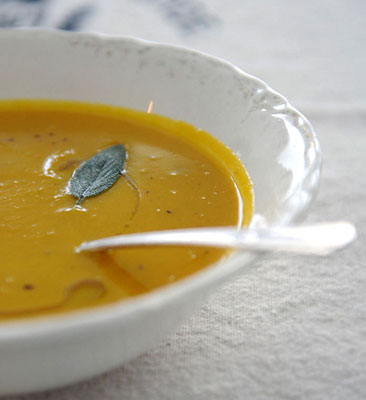 Stuffing, mashed potatoes, sweet potato casserole, green bean casserole. Most people will say that Thanksgiving isn't a holiday without these traditional dishes, but that doesn't have to be the case. Although they are classics, it doesn't mean they can't be reinterpreted, reimagined, or replaced with an equally interesting seasonal side dish. When vegetarians are around, it's also courteous to keep them in mind when planning the menu.
Stuffing, mashed potatoes, sweet potato casserole, green bean casserole. Most people will say that Thanksgiving isn't a holiday without these traditional dishes, but that doesn't have to be the case. Although they are classics, it doesn't mean they can't be reinterpreted, reimagined, or replaced with an equally interesting seasonal side dish. When vegetarians are around, it's also courteous to keep them in mind when planning the menu.
Rice rarely gets attention on Thanksgiving. Some people make it just in case it's requested, but most often it's ignored altogether. Rice pilaf is actually a very appropriate dish to serve at Thanksgiving. This recipe, made with wild rice and quinoa, is perfect for the holiday. It's altogether symbolic of the season and is studded with toasted pecans and pomegranate seeds. It's a good side kick or even alternative to classic dishes, such as stuffing.
Wild rice is very American. It was and still is cultivated by Native Americans. But it's actually not a rice but a seed of a grass that grows in marshy areas and it can only be collected by boat. Pecans are a specialty of the South, where pecan trees are everywhere. So what could be more American than this dish? The addition of quinoa, a South American grain, adds protein and texture to the dish. Gladly serve it to the vegetarians in your family.
Fall
Fall
Squash Soup
 There is magic in these fields we have - the kind of magic that store bought soil or fertilizer cannot bring about. It's a magic that I can only be a part of in the smallest of ways and then the rest is up to the sun, moon and stars. When we moved here, there were scrubby weeds that had grown taller than my husbands face and not an ounce of decent soil existed beneath them, but as the rains have given us grass, the cows have provided rich manure and so the circle of restoring our land began.
There is magic in these fields we have - the kind of magic that store bought soil or fertilizer cannot bring about. It's a magic that I can only be a part of in the smallest of ways and then the rest is up to the sun, moon and stars. When we moved here, there were scrubby weeds that had grown taller than my husbands face and not an ounce of decent soil existed beneath them, but as the rains have given us grass, the cows have provided rich manure and so the circle of restoring our land began.
During the process of turning weeds and waste into true fertile soil, we've had the suprise of volunteer squash vines growing in great numbers. I'm completely humbled by the massive plant with it's very own intentions and whether or not I am there to trellis the tendrils or support it's fruit, the squash lives on through sun and storms.
Tip toeing amongst the mound of vigorous vines, I fall so in love with the eagerness of life that surrounds us. Everywhere I turn, life is happening in a way that is supported by a chain of different species. We all depend so greatly on eachother to grow.
Autumn Veggie Soup
 Roast em and stew em - that's all there is too em!
Roast em and stew em - that's all there is too em!
I don't know about y'all, but I roast just about everything I can. Veggies, fruit and meats all get nice and toasty and caramelized from high heat and a little salt to draw out the moisture. Roasting veggies has become my MO for getting picky eaters (y'all know who you are) to eat all kinds of veggies. Broccoli, cauliflower, Brussels sprouts, okra, zucchini, squashes of all sorts and onions too all find their way into the oven and onto plates. Roasted sweet potatoes with rosemary and onion... Oh my my!
I love, love, love vegetable soup. But I have a few stipulations to this stew of sorts. I don't care for potatoes in my veggie soup - can't say why exactly but I don't. Potato soup though is perfectly fine!
Pumpkin Cake
 Pumpkin is one of my favorite ingredients, especially during the fall months. This is a great cake for friends with October/November birthdays (like me!)
Pumpkin is one of my favorite ingredients, especially during the fall months. This is a great cake for friends with October/November birthdays (like me!)
It’s also a nice alternative to pumpkin pie at Thanksgiving.
Feel free to substitute whole wheat or white wheat flour for the all-purpose.
Pumpkin Cake:
3/4 cup (6 oz.) unsalted butter; more for the pans
2 teaspoons ground cinnamon
1 teaspoon ground ginger
1/2 teaspoon ground cloves
1/4 teaspoon ground nutmeg
2 cups (9 oz.) unbleached all-purpose flour; more for the pans
1 teaspoon baking soda
1/2 teaspoon baking powder
3/4 teaspoon table salt
1 1/2 cups granulated sugar
2/3 cup firmly packed light brown sugar
1 1/2 cups pumpkin puree
2 large eggs
1/3 cup buttermilk
Cream Cheese Frosting:
2 sticks unsalted butter, softened
4 cups confectioners' sugar
16 ounces cream cheese, cut into 8 pieces, softened
1 1/2 teaspoons vanilla extract
Pinch salt
Creamy-As-You-Like Beet Soup
 Beets are like paint bombs. Deliciously sweet, red, flavored paint bombs, so intensely colored they stain your fingers, bleed into the sink, tint the cutting board, you name it. When cooked, they aren't so much red as deep magenta. When mixed with sour cream they turn paler shades of magenta to pink. The color, like the flavor is either something you love or you hate.
Beets are like paint bombs. Deliciously sweet, red, flavored paint bombs, so intensely colored they stain your fingers, bleed into the sink, tint the cutting board, you name it. When cooked, they aren't so much red as deep magenta. When mixed with sour cream they turn paler shades of magenta to pink. The color, like the flavor is either something you love or you hate.
Beets get a bad rap from the low carb police, but they are actually quite healthy, filled with antioxidants, low in calories, they have significant amounts of fiber, folate, manganese and potassium. I know some people find beets too "earthy" tasting, but both Lee and I love 'em. Especially in beet soup.
There are an unbelievable number of recipes for beet soup. It's commonly served all over Eastern Europe. There are versions that are cold, hot, vegetarian, with meat, chunky, smooth, with tons of vegetables, with no other vegetables.
Lately I've been experimenting with "less is more". I've tried stripping down various recipes to the barest of basics to see if I could coax the ingredients to shine through. This is one of those recipes. In my experiment to get to the essence of the beet, I developed a recipe that has little more than beets in it at all. A pinch or two of sugar perks up the flavor and the broth and sour cream add body and richness.
More Articles ...
Welcome to the new One for the Table ...
Our Home Page will be different each time you arrive.
We're sure you'll find something to pique your interest...


